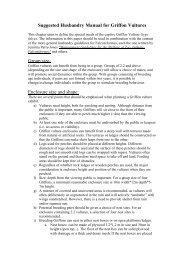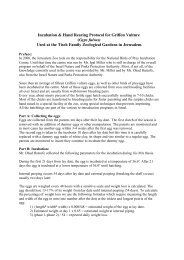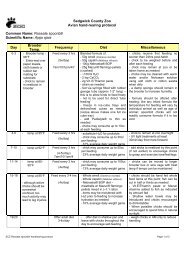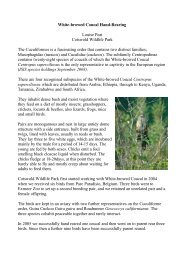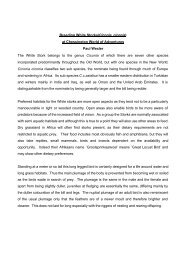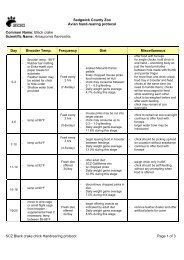The Laughing Kookaburra and their hand rearing - Avian Rearing ...
The Laughing Kookaburra and their hand rearing - Avian Rearing ...
The Laughing Kookaburra and their hand rearing - Avian Rearing ...
You also want an ePaper? Increase the reach of your titles
YUMPU automatically turns print PDFs into web optimized ePapers that Google loves.
THE LAUGHING KOOKABURRA (Dacelo novaeguineae)<br />
AND THEIR HAND REARING AT BIRDWORLD<br />
Paul Wexler<br />
<strong>The</strong> <strong>Laughing</strong> <strong>Kookaburra</strong> is the largest of the 87 species of Kingfisher which occur almost world wide.<br />
Though not as colourful as some of its smaller cousins it is none the less a beautiful bird <strong>and</strong> its call is<br />
something that one can only marvel at.<br />
<strong>The</strong>se <strong>Kookaburra</strong>s are classed with three other close relatives in the genus Dacelo, two of which occur on<br />
New Guinea <strong>and</strong> some of its surrounding isl<strong>and</strong>s. <strong>The</strong> remaining two, the Blue winged <strong>Kookaburra</strong> (Dacelo<br />
leachii) <strong>and</strong> the <strong>Laughing</strong> <strong>Kookaburra</strong> have the largest part of <strong>their</strong> distribution in Australia. For the <strong>Laughing</strong><br />
<strong>Kookaburra</strong> the single sub species (D. n. minor) has its range through the Cape York Peninsula to about 15<br />
degrees south of the Equator. <strong>The</strong> nominate form is present from the point where the sub species range<br />
finishes, throughout the east of the continent in central Queensl<strong>and</strong>, New South Wales <strong>and</strong> south east<br />
South Australia. <strong>The</strong>y are also present in the extreme south west of Western Australia. Off the mainl<strong>and</strong><br />
they occur on Tasmania <strong>and</strong> around Auckl<strong>and</strong> on New Zeal<strong>and</strong>s' North Isl<strong>and</strong>, though these isl<strong>and</strong> colonies<br />
are the result of artificial introductions.<br />
Natural food is looked for on the ground as opposed to in water, which means that the major part of <strong>their</strong> diet<br />
is made up of lizards, snakes <strong>and</strong> insects. Small mammals, birds <strong>and</strong> amphibians are taken to a lesser<br />
degree. Bird table scraps will be utilised in urban habitats <strong>and</strong> fish will also be taken from shallow pools.<br />
<strong>The</strong>ir feeding strategy is to sit on an open perch <strong>and</strong> observe the ground below. On seeing a suitable prey<br />
item they will fly down (by hovering <strong>and</strong> or diving) <strong>and</strong> l<strong>and</strong>ing beside the animal instantly seizing it. Once<br />
caught the prey may be killed by being beaten on the ground or be taken back to a perch for similar<br />
treatment. Some large or venomous snakes may even be taken to a high perch <strong>and</strong> dropped to stun them<br />
before being collected <strong>and</strong> beaten <strong>and</strong> then eventually swallowed whole.<br />
Two breeding pairs of <strong>Kookaburra</strong>s are currently kept at Birdworld, one pair (pair A) have been held since<br />
1988, the second (pair B) is made up of a male received in 1988 <strong>and</strong> a female bred at Birdworld from pair A<br />
in 1991. This second pair was made up early in 1994.<br />
<strong>The</strong> basic diet given is chopped day old chicks sprinkled with vitamin powder which are fed each morning.<br />
Occasionally sprats or s<strong>and</strong> eels are fed along side the chicks, but they are not readily taken. Mealworms<br />
will also be eaten, but are not fed regularly.<br />
1
Pair A are kept in a large mixed species aviary with Black capped Night Herons (Nycticorax nycticorax),<br />
Crested Seriema (Cariama cristata) <strong>and</strong> Temmincks Tragopan (Tragopan temmincki). Pair B are housed<br />
alone with Temmincks Tragopan, in a smaller, but well covered aviary.<br />
Nest boxes for both pairs are fixed in the aviaries all year. <strong>The</strong>y are sloped at 45 degrees, 3' deep with a<br />
base area of 12" square. A mixture of peat <strong>and</strong> bark chippings is used to line the box <strong>and</strong> this is changed<br />
twice each year.<br />
Eggs are first laid between early April <strong>and</strong> mid May, usually three are produced per clutch <strong>and</strong> because of<br />
occasional failings in the past where the parents have not successfully hatched or reared <strong>their</strong> offspring we<br />
have undertaken to incubate <strong>and</strong> h<strong>and</strong> rear the first clutches of each pair, leaving the second or third<br />
clutches for the parents to attempt. After the removal of eggs a period of about three weeks is needed for<br />
the female to recycle. Parent <strong>rearing</strong> normally only results in one successfully reared chick per pair per<br />
year, if any are produced at all.<br />
Once chicks to be left with the parents are due, supplementary feeds are given to aid the chicks to be<br />
reared successfully. <strong>The</strong>se feeds consist of small pieces of day old chicks <strong>and</strong> mealworms placed in the<br />
aviary two or three times a day until the <strong>Kookaburra</strong> chicks are about fourteen days old when the are able to<br />
accept pieces the size of those regularly given for the adults.<br />
<strong>The</strong> 1995 season saw three eggs produced from each pair, pair A had finished laying by the 3rd of April, pair<br />
B by the 11th of April. Both clutches were removed for artificial incubation.<br />
<strong>Laughing</strong> <strong>Kookaburra</strong> eggs appear almost spherical <strong>and</strong> are completely white, measuring on average (from<br />
48 eggs) 44.6mm X 37.1mm <strong>and</strong> weighing 33.7 grams. <strong>The</strong>y are incubated at a constant temperature of<br />
37.5 degrees C. <strong>and</strong> the correct weight loss was obtained with a wet bulb temperature of 80 or 84 degrees f.<br />
(46% or 55% relative humidity). Being turned automatically 96 times a day <strong>and</strong> additionally 5 times by h<strong>and</strong><br />
good vein growth within the egg is produced. <strong>The</strong> total incubation period is 25 days, but on about day 23,<br />
once the chick has begun to make its initial movement into the air cell, the eggs were taken from the<br />
incubator <strong>and</strong> put in to a hatcher, where the temperature was a constant 36.5 degrees C. <strong>and</strong> the humidity<br />
as saturated as possible. <strong>The</strong> added humidity simply makes the membranes <strong>and</strong> the shell softer <strong>and</strong> thus<br />
makes the emergence of the chick hopefully easier.<br />
2
Once hatched the young chicks are generally left in the hatcher for a few hours before being removed <strong>and</strong><br />
put in to a brooder set at 36 degrees C.<br />
<strong>The</strong> first feeds are offered about twelve hours after hatching <strong>and</strong> are simply a few small pieces of pinkie<br />
mouse or leg meat off a day old chick which when held with a pair of tweezers, are touched gently on the<br />
side of the chicks' beak to encourage them to beg. As a matter of course all feeds of this nature are given a<br />
dusting of vitamin powder in an effort to keep the diet adequate.<br />
<strong>The</strong> weight of a newly hatched <strong>Kookaburra</strong> is about 24 grams. <strong>The</strong>y may lose 1 or 2 grams in the first 24<br />
hours though after the second day, with three hourly feeds between 8am <strong>and</strong> 8pm, weight gains of up to<br />
25% per day can be achieved. After three or four days the feed at 8pm can be stopped.<br />
<strong>The</strong>se chicks have no crop, so food is swallowed straight into the stomach <strong>and</strong> to gauge the correct amount<br />
of food being fed at each meal one needs to feel the tension of the skin around the abdomen, if this feels full<br />
without being over tight, then the bird is sufficiently full. Record the number of items or the weight of food in<br />
each feed, then check this against the weight gain the following morning. If the weight has gone over 15%<br />
or so, then it is safe to reduce feed quantities bearing in mind that each day the chick will require relatively<br />
more than the previous day.<br />
At about three days <strong>Kookaburra</strong> chicks have begun to show signs of intolerance to low humidity in the<br />
brooder, with most of the dorsal skin showing signs of peeling, this is easily rectified by placing a bowl of<br />
water in brooder. As a result of this occurring in the past, we tend now to make a practise of leaving some<br />
water in the brooders as soon as <strong>Kookaburra</strong> eggs are expected <strong>and</strong> retain a level of humidity until the first<br />
feather quills begin to come through, usually at about 8 or 9 days old.<br />
By about 12 or 15 days old a chick will be able to take enough food in three feeds to produce a good weight<br />
gain <strong>and</strong> so feed times are reduced <strong>and</strong> given at 8am, noon <strong>and</strong> 5pm, this practise is carried on until it is<br />
time for the chicks to wean.<br />
Weaning a <strong>Kookaburra</strong> for the first time can easily be quite traumatic for the rearer. Once the chicks, well<br />
feathered by now, have reached 300-320 grams usually around 30 days old they will stop taking food. <strong>The</strong>y<br />
are then transferred to a cage where they are left to learn to perch on low perches which they tend to use<br />
readily. A dish of chopped chicks are placed in the cage twice a day <strong>and</strong> at the same time a little offered by<br />
h<strong>and</strong> to the chick. At this stage it is nearly always met with rebuke which is when trouble is first<br />
suspected. With hindsight however we have found that this refusal to take food which results in a quick<br />
3
weight loss, on occasions down to 230 grams before the appetite returns is necessary. <strong>The</strong> chicks begin to<br />
change appearance slightly, the belly starts to become smaller, thus loosing its' flabby appearance, the<br />
flight feathers grow <strong>and</strong> are seemingly faultless despite <strong>their</strong> period of self starvation culminating in a bird at<br />
about 260-280 grams which will begin to fly <strong>and</strong> should be feeding confidently by itself.<br />
It can only be assumed that loosing <strong>and</strong> gaining weight so dramatically at this time of life is similar to the<br />
process undergone by those fledging naturally. Possibly this will give nestlings a chance to reduce <strong>their</strong><br />
`puppy fat' <strong>and</strong> put the last inch or so into the flights before they are coaxed out of the nest by the parents.<br />
We have also been able to witness this year, a h<strong>and</strong> reared bird which was kept very tame for two <strong>and</strong> a half<br />
years, successfully hatch <strong>and</strong> rear her own chick, which helps to prove the usefulness of h<strong>and</strong> <strong>rearing</strong> as a<br />
captive breeding technique.<br />
4



